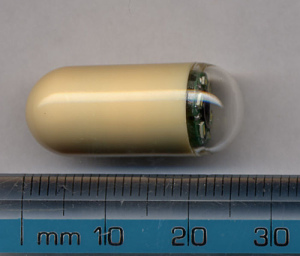The Role of Endoscopy in Treating Dyspepsia
by
Joan Trombetti, Writer | January 02, 2008

Wireless capsule endoscopy,
is a camera in
the size and shape
of a pill used to
visualize the
gastrointestinal tract.
Dyspepsia is a discomfort that is thought to arise from the upper-gastrointestinal tract. Dyspepsia affects approximately a quarter of the population in Western countries. The American Society for Gastrointestinal Endoscopy (ASGE) has issued guidelines for the role of endoscopy in treating dyspepsia. (An upper endoscopy procedure uses an instrument to assess the inside of the esophagus, stomach and small intestine.) The guidelines were prepared by ASGE's Standards of Practice Committee and appear in the December issue of Gastrointestinal Endoscopy, the monthly peer-reviewed scientific journal of the American Society for Gastrointestinal Endoscopy.
Dyspepsia may include a variety of more precise symptoms, which can include epigastric discomfort, bloating, anorexia and heartburn. These nonspecific symptoms can be indicative of an underlying diagnosis like peptic ulcer disease, GERD, functional disorders (non-ulcer dyspepsia) and malignancy. The appropriate role of endoscopy in the evaluation of dyspepsia is both a realistic concern for the gastroenterologist and an important factor in healthcare costs.
Todd Baron, MD, chair of the ASGE Standards of Practice Committee stated that since dyspepsia affects large numbers of people across a broad spectrum of symptoms, it is not practical to perform endoscopy in all patients with dyspepsia. He said, "in review of the medical data available, we concluded in these guidelines that age and alarm features offer the best guidance for the physician in managing patients and in determining if an endoscopy is appropriate treatment."
Patients With Alarm Features (Symptoms)
Endoscopy offers the chance for early diagnosis of structural disease because dyspepsia is not only a convenient descriptor for upper-gastrointestinal (GI) symptoms, but also a marker for the risk of structural disease: malignancy is present in 1 to 3 percent of patients with dyspepsia, and peptic ulcer disease in another 5 to 15 percent.
Age and alarm features have been used in an attempt to identify those patients with dyspepsia who have structural disease. The alarm features include new onset of symptoms in someone over 50, family history of upper-GI malignancy, unintended weight loss, GI bleeding or iron deficiency anemia, progressive trouble swallowing, pain with swallowing, persistent vomiting, palpable mass or lymphadenopathy, and jaundice.
The guidelines recommend that patients older than 50 years of age with recent onset of dyspepsia or patients of any age with alarm features should undergo an endoscopy. An endoscopy should also be considered for patients in whom there is a clinical suspicion of malignancy even in the absence of alarm features.
